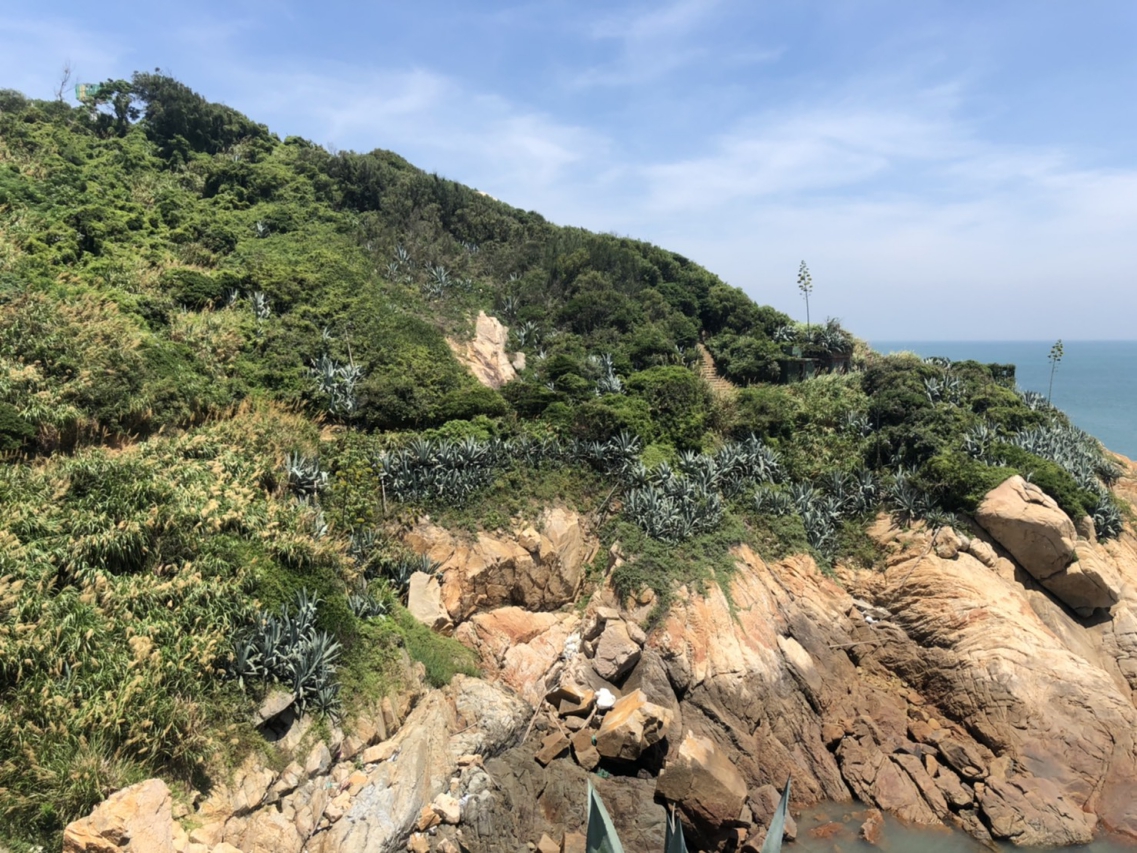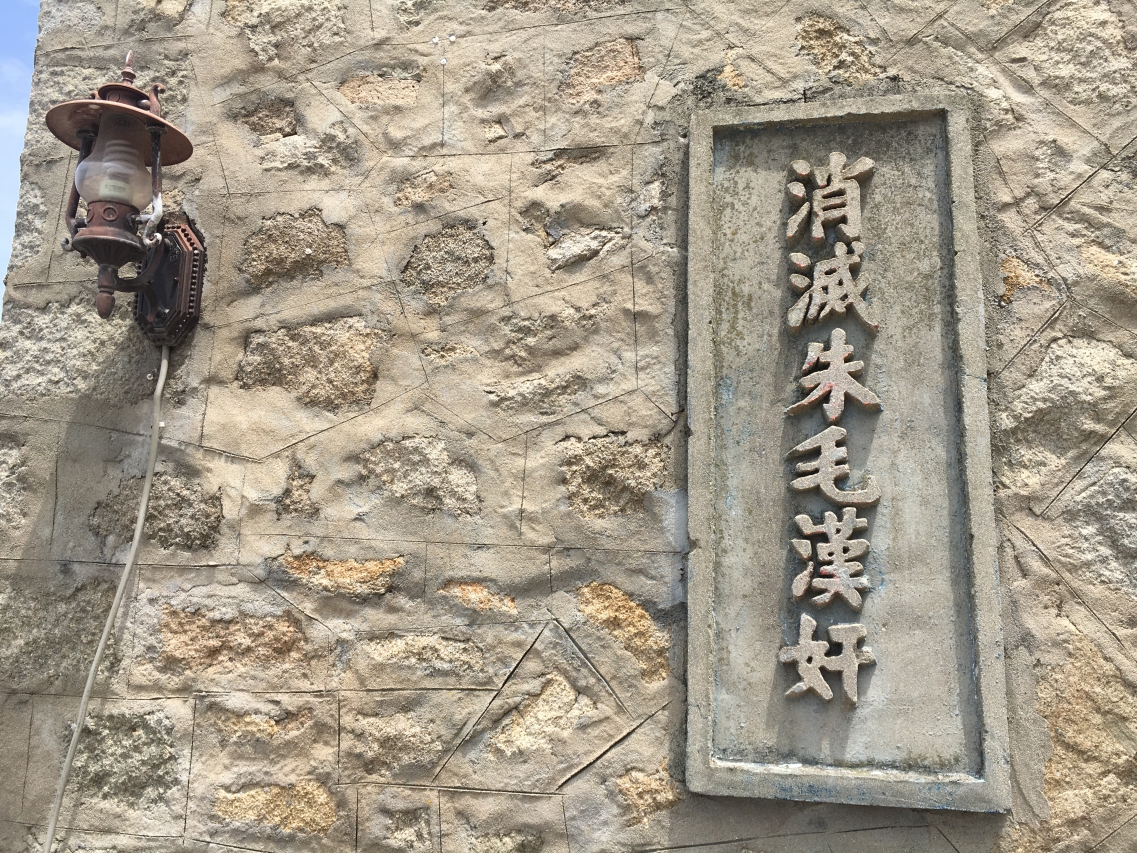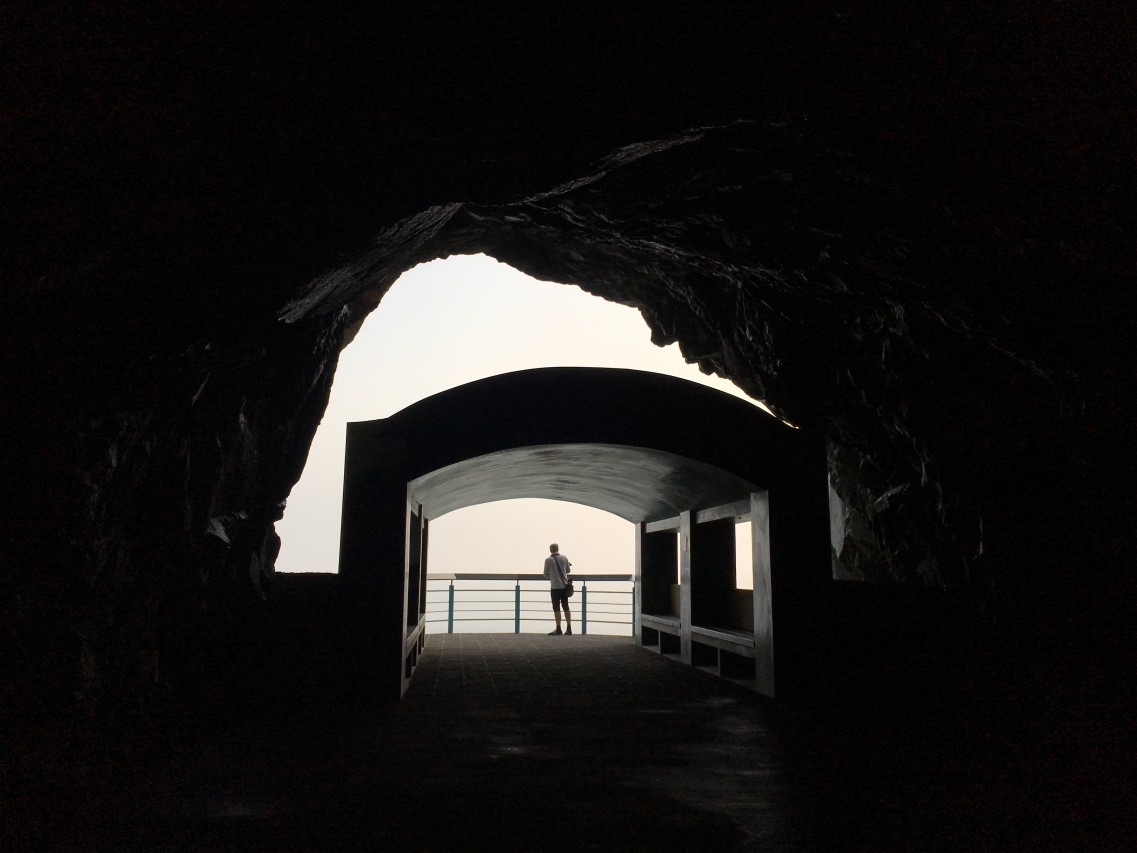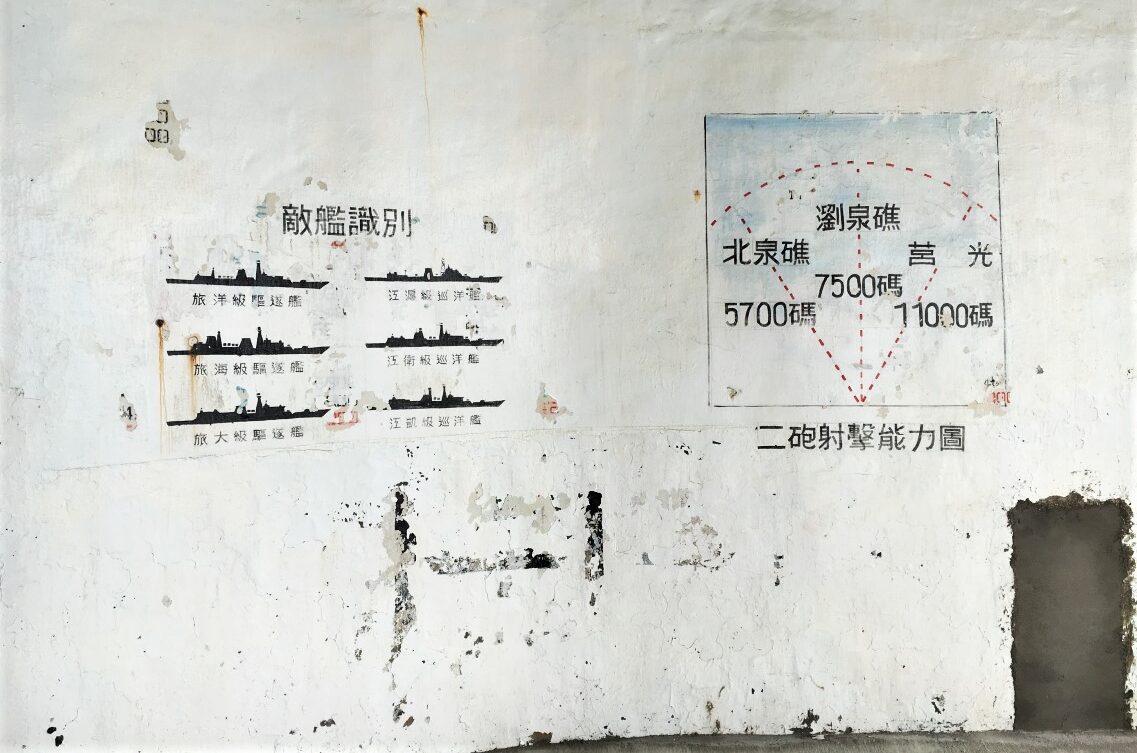沿著南竿機場航廈右側的道路駛去,經過飛航管制區,彎進一條看似沒人駛入的林間小徑,我們來到機場南側跑道的水泥結構下方,旁邊的樹葉在車輛穿行的時候打在車窗玻璃上。「真的是這裡嗎?」我懷疑地問,「是這裡沒錯,以後僅能步行進來,就像穿入隧道一樣……」好多樣文化工作室的廖億美這樣回答我們。前往馬祖南竿26據點必經路徑上的重重障礙,也像是我對於馬祖的理解,每次來到都看到不同的面貌,在多層偽裝底下、眼見卻不一定為真,除去覆蓋其上的荒草之後,等待我的往往是更多待解的謎。
距離我第一次造訪馬祖,已經兩年有餘。在未踏上島嶼之前,我對馬祖的印象都停留在地理課本的知識:臺灣遙遠的離島、跟金門同為戰地前線的歷史背景。勉強套個關係,大概就是我父親曾經在馬祖當兵。因此,在只有一知半解的認知下,當我初次踏上這個「前戰地」時,訝異於當地人講的方言並非同金門一般近似閩南語,在我聽來馬祖話更像是廣東話的遠房親戚;建築受到閩東文化的影響、飲食習慣跟食物的風味也有別於臺灣本島;又或者讚歎於廢棄碉堡海天一色美景的當下,突然意識到過去這個與共產中國一海之隔前線曾經歷過的壓抑與恐懼。島上隨處可見的「枕戈待旦」、「同島一命」這些標語,也標示出影響在地社群的緊密連結,以及歷史必然因素下和軍方的微妙關係。種種衝突和交雜的情緒構成了我對馬祖的理解,然而每次因為不同的原因造訪,層層抽絲剝繭、深入探訪,終能看到馬祖充滿魅力的多重面貌。戰地文化、地緣政治、在地社群盤根錯節的關係與故事總是給我帶來驚喜。和同為戰地的金門相比,戰爭未曾真正降臨馬祖,然而同為戰事前線的島嶼位置,它過去經歷了一段非常長期的準備戰爭、等待戰爭的壓抑過程,也造就了這座島嶼的不同。
曾經聽過朋友開玩笑說,馬祖的貧窮線是三間房子:一間在馬祖、一間在臺灣,還有一間在中國。國共內戰之後,連江縣一分為二,中華民國政府實質上管轄的連江縣,含括四鄉五島:南竿、北竿、東莒、西莒、東引以及其附屬的共36座島礁。而對岸中國福建省也有一個人口更多,幅員更廣的「連江縣」。馬祖列島與中國隔海相望,當天氣晴朗的時候,肉眼可以看到對岸中國,甚至連黃岐半島的風力發電廠都能看得一清二楚。馬祖距離最近的中國領土約莫只有9公里,但是距離臺灣卻有211公里,船行從基隆港到南竿島約莫是七個小時,然而小三通後從北竿白沙港只要25分鐘就可以到黃岐。每年4、5月旅遊旺季開始,湧入大量的觀光客,多數旅客選擇搭乘飛機到馬祖,只需50分鐘的飛行時間。然而旅遊的旺季也是馬祖的霧季,當飛機停飛時,便利商店的物品被一掃而空,除了滯留的觀光客之外,物資也停滯在臺灣無法運補進入馬祖,只能經由船運一途。
 馬祖的海岸沿線栽種大量的瓊麻,也是過去掩飾軍事建設、防衛海防的重要植物。圖/王萱攝影
馬祖的海岸沿線栽種大量的瓊麻,也是過去掩飾軍事建設、防衛海防的重要植物。圖/王萱攝影
明朝以降,馬祖原為一個中國沿海的漁業聚落,東莒島上至今保留當時驅趕海盜的石刻遺跡。馬祖四鄉五島都被海給包圍,為了完備防禦功能,幾乎每個島嶼沿著海岸線遍佈海防據點,光是行政中心――南竿就有95個軍事據點。這些軍事據點多半是沿著地勢而建的碉堡,多數具有坑道、機槍堡等設備,較大規模的更具備地上建物作為寢室或是其他集會、操練用途。建築物因著地形有工法上的差異,可能是挖空一個山頭鑿出來的,也有用水泥預鑄之後在於其上覆土、栽種常見的植栽:瓊麻,來掩飾軍事據點本體。而瓊麻除了有建築物保護色的功能之外,如鳳梨般的尖刺葉子,更具有防禦空襲降落的敵方的功能。這些碉堡多半位於海天一色的景觀之中,以觀光旅遊發展的角度來說,絕對是打卡拍照的絕景。但是如果時光倒回兩岸對峙的年代,這些軍事據點卻是保家衛國的最前線、緊密的防禦網絕不能有半點疏漏。夜晚時士兵輪值在海邊站哨,「絕景」瞬間就是「絕境」了。因為除了要打起精神對戰瞌睡蟲,還要嚴防水鬼1摸哨,海天一色瞬間變成生死一瞬間。
1992年解除戰地政務之後,這些軍事據點除了部分仍具有重要及必要戰略地位維持隨時備戰狀態之外,多數湮沒在荒草與時間之中。而馬祖也搖身一變,從一個抵抗的前線,轉變為交流的節點。1999年成立馬祖國家風景區,2000年開放小三通,馬祖成為臺灣與中國往來頻繁的前哨站。從交戰到交流,馬祖致力於開放觀光轉型,填補軍隊撤防之後大量消費力的短缺。不落俗套的,這個島嶼也曾面臨博弈特區的議題是否為島嶼經濟的解套方式,然而這個島上的人們,在不同的溝通、討論、與世代對話中,明白島上的資源有限,以可運用的優勢,努力趨近並發展屬於馬祖永續發展的道路。時至今日,島嶼開放交流逾20年,馬祖正在經歷「去戰地」的新階段:梳理戰地背景形成這座島嶼的歷史事實和特色文化,重新建構社群溝通的方法學。從世界遺產潛力點、再造歷史場景,位居東亞島鏈(第一島鏈)戰略地位的冷戰歷史,馬祖透過如何保留軍事遺產、戰地政務時期的軍民集體記憶和故事,軍事遺構的活化再利用等議題開啟對話,並且展開一場在保有在地歷史脈絡和地方創生之間取得雙贏甚至「多贏」的實踐。

馬祖有著非常緊密的人際網絡,得從過去馬祖經歷過的幾個時期來說。踏上這塊靠近中國的臺灣領土邊際,「同島一命」、「反攻大陸」、「枕戈待旦」這些看起來和現代社會有點距離的精神標語,遍佈島上各地,在在提醒我們島嶼與它的住民們所經歷的戰地時期。馬祖原是中國沿海閩東地區的邊陲漁村,在國共內戰之後,國民黨政府退守臺灣,馬祖搖身一變成為抵抗共產中國的最前線。截至1992年解除戰地政務時期之前,島嶼上經歷了數十年的備戰時期。以南竿為例,島嶼海岸線的先天地理條件,使得居民多半集中居於澳口處,便於漁業與航行。進入戰地政務時期之後,海岸線變為防禦的前線,甚至也有民地被徵收作為軍事用途,整座島以扼守福澳港、清水澳和珠螺澳的01據點(勝利堡)起始開始沿著海岸線築起堡壘,全島遍佈95個軍事據點,成為一道鐵壁防護。
當時馬祖人無法任意旅行到臺灣,如要赴臺必須辦理特別的許可證,馬祖更擁有區域通行的貨幣 2。「保密防諜」、「軍民一家」是口號也是共識,馬祖居民組成民防自衛隊,不分男女皆備戰。每個村落宵禁之後,必須要報上通關口令才能放行,並且定時更換,嚴防匪諜入侵。軍民共居則是變成常態,甚至是因為軍事用途而徵收民地;過去賴以為生的漁業,因為高度戒備的戰地狀態,而有所限制。除了共居狀態,產業類型也受到極大的影響,多數馬祖居民轉型從事服務軍隊的工作,包含雜貨店、餐飲業、軍事用品文具店,各種休閒娛樂:從早期的彈子房(撞球場)、KTV到網咖,隨著時代改變因應島上的主要消費者:阿兵哥。
 馬祖安東坑道一景,位於東引島。圖/黃又文攝影
馬祖安東坑道一景,位於東引島。圖/黃又文攝影
在戰地政務的特殊時期壓抑下,馬祖的集體記憶是失語的,有著許多的不可言說、無法言明的複雜情緒。而在解除戰地政務時期之後,也面臨居民結構變化、軍人大量減少、產業轉型的課題。在地社群的緊密關係,使得許多公共議題在不同世代的溝通間產生許多衝突,也經歷過緊張的時期。從旁觀的角度來看,筆者所接觸到的在地青年,不論是回流返鄉或是因為被馬祖吸引而移居的青年世代,透過不同的方法理解與包容,拉近不同世代與群體、建構社群對話的新方法。如長期致力於深化地方文化實踐的好多樣文化工作室、費時兩年整修珠螺國小,這個夏天開始有據點的馬祖青年發展協會、每次到馬祖都想要去漫步一下仁愛村(舊稱鐵板)並且去南萌咖啡館坐坐,還有收集東莒11位婦女的傳統老酒紅糟料理的好東島,以及活化東莒大埔聚落的大浦plus+,不僅官方,民間的力量也正持續對話,重新發掘馬祖的魅力與價值。
由戰地轉為觀光,馬祖每年湧進數萬遊客觀賞藍眼淚。藍眼淚實為一種夜光蟲(渦鞭毛藻),關於藍眼淚為何會出現的原因根據研究有各種不同的說法 3,在我第一次造訪馬祖的時候也不免俗的去北海坑道夜間「觀淚」。北海坑道內無光害,搭乘划槳的小船,工作人員指引參加體驗的觀眾用手上的槳輕撥水面,藍眼淚便會現身。然而,群眾看到奇景的興奮之情難以控制,如果從夜光蟲的視角來看,便是一波人類大舉入侵,瘋狂擾動夜光蟲族群,牠們只好一直發出威嚇敵人的螢光……。
在馬祖的軍事遺產們給予我許多生態啟示,雖然北海坑道是因為軍事目的「北海計畫」而建立軍事遺址,今日卻成為了每年藍眼淚群聚的環境。許多海防據點也是「觀淚」、「追淚」的熱點,因為鮮少有人類活動(已經無軍隊駐紮,或是船舶及漁業),加上光害少,海浪打在岸邊礁岩上,點點藍光漾在海面上蔚為奇景。也讓筆者常常想起2019年在芬蘭Örö島上做的計畫,Örö島和馬祖非常類似,是一個備戰的軍事島嶼,但卻因為限制進出與高度戒備,反而保留下許多物種,如特殊的蝴蝶種類。而在脫離軍事戒備之後,島嶼的人類足跡減少,許多生物足跡再現。戰爭是危險的,然而對於其他物種,人類足跡才更危險。當人類足跡退出,其他物種反倒有了生存空間。
 南竿鄉鐵板村大漢據點的軍事牆面壁畫,作為識別敵艦之用。圖/黃又文攝影
南竿鄉鐵板村大漢據點的軍事牆面壁畫,作為識別敵艦之用。圖/黃又文攝影
在馬祖,曾經扮演島嶼防衛第一線的海防據點,除了是重要的軍事遺產,以原樣保留成為銘刻戰地文化、展現歷史的載體之外,在近幾年陸續釋出,有了更多的可能性。比如刺鳥咖啡書店,便是12據點轉型成的獨立書店;或是55據點背包客棧,是由馬祖當地青年重新改造而成的特色旅社。從去戰地的第一階段:原樣保存,呈現戰地遺址;到第二階段:機能改造,保留戰地特色,轉化成具備其他功能的體驗空間;馬祖的軍事遺產在同一個時空並存不同時代的狀態,也正邁向第三階段:轉譯與再生,以設計力和文化力,叩問建築空間、歷史文本、社群關係、人與環境等種種實驗與對話。
筆者在疫情爆發初期的去年2月造訪馬祖,在地社群緊密的連結反而讓島上成為最安全的地方,誰沒戴口罩、哪裡來了陌生人進出,過去「保密防諜」反而成為防疫最堅實的後盾。而在下半年加入「戰地轉身.轉譯再生」的計畫,於夏天再次到訪,除了田野調查之外,也為即將進入「建築轉譯計畫」的26據點、53據點、77據點和86據點留下紀錄。透過團隊中其他夥伴建築師、藝術家、影像導演、攝影師,經由訪談、記錄以及創作,實驗凝視島嶼的嶄新方法學。馬祖就像一個我心中的桃花源,希望你也能找到路徑,看到他表象之下的多重魅力。